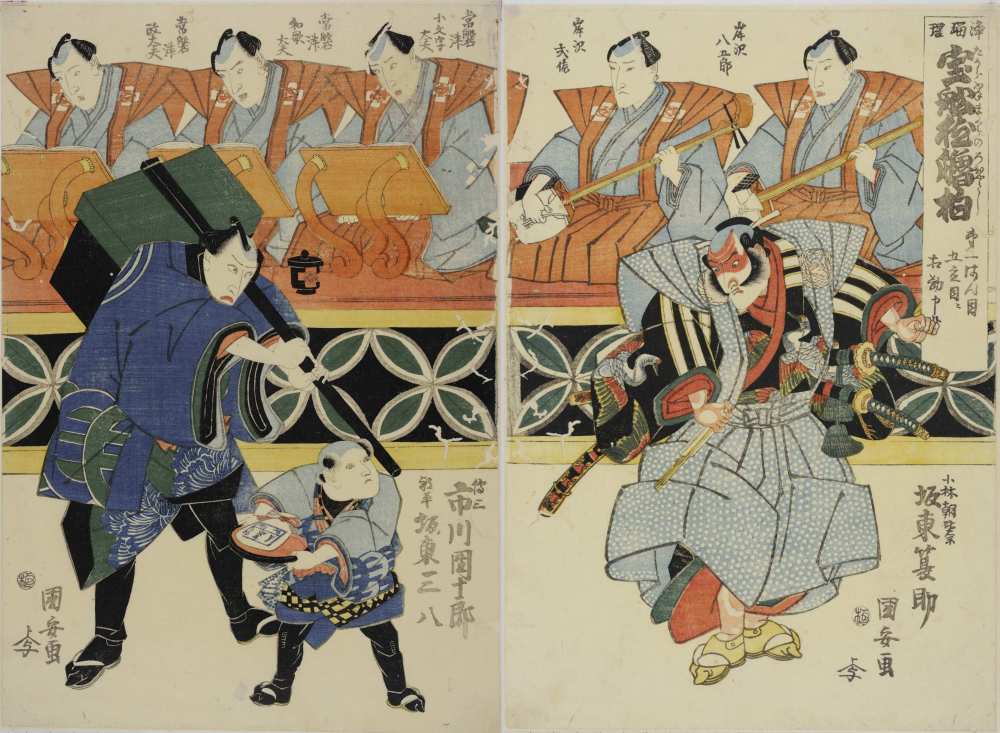F01 Kabuki Music
-
"Joruri Takarabune makura no robyoshi Dai ichi-hanme Go-tateme ni aitsutomemoshisourou"
Artist: 国安 Oban, Colour print
Performance: 22 January, 1828(Bunsei 11) Ichimura-za theatre, in Edo
興行名:二葉春花麗曽我 所作題: Takarabune makura no robyoshi
Ritsumeikan Art Research Center(arcUP4188,4189)The music played in Kabuki theatre generally can be divided into two genre, except for Gidayubushi which expedites the proceeding of the drama. Shosagoto (dance pieces) music is an accompaniment for dancing performance, and Geza music, music played off the stage, is for background music and sound effect of performance.
Two remarkable differences between them are a position of Shamisen (or Samisen) and players position on the stage. In Shosagoto, Shamisen is a essential instrument to play melodic songs accompanied by lyrics. In contrast, in Geza music, it is not necessary. As you can see in the picture, Shosagoto music is often played on the stage, so this is called Degatari, ballad performance on the stage. In contrast, Geza music player plays at the space back of Kuromisu (black curtains) placed on Geza (stage right), so it is also called Kuromisu ongaku, music played .
Gidayubushi plays an important role as a narrator, reciting a ballad-drama and moving a story forward, in Kabuki programs based on Ningyo Jyoruri (puppet play, also called shortly "Jyoruri") programs called Gidayu kyogen, and sometimes even play the part of Shosagoto music of Michiyuki (travel scene).
For Shosagoto music, Jyoruri music are often used, and the most famous among them are called the three major schools of Bungobushi, such as Tokiwazu, Kiyomoto, and Tomimoto. Add to this, Katobushi and Icchubushi, can be grouped into the ballads before Bungobushi, is still remaining today. Sometimes, not only these traditional schools but new Gidayu schools such as Shinnaibushi performed on stage as well. Exceptionally, Nagauta (lit. long song), which belongs to Geza music, plays a role of Shosagoto music as Debayashi, Geza music performance on the stage.
This picture describes Tokiwazu (Shosagoto) player's performance on a dance piece "Takarabune makura no robyoshi", a scene from "Futaba no nigiwai soga", one of variations of Soga kyogen which are popular program performed in early spring. Shamisen players and Tayu (ballad singer) wear Kamishimo (ceremonial kimono) and lined up on Yamadai (raised platform) so that audience can see them playing on the stage. Basically, Yakusha-e (actor's print) depicted only actor and background and omitted the other, but in some case, Shosagoto players also appeared on the pictures. This fact shows the popularity of the accompaniments.
The casting at this performance is Bando Minosuke the second as Kobayashi Asahina, Ichikawa Danjyuro the seven as Denzo, Bando Sanpachi the third as Asahira, Bando Mitsugoro the third as Suketsune, Iwai Kumesaburo the second Toragozen. In the background, we can see Tokiwazu players are playing music in front of vermilion-lacquered book stands with curved legs, a characteristic tool of Tokiwazu school. (,)[Glossary]
義太夫節、豊後節、常磐津節、富本節、清元節、河東節、一中節、新内節、長唄、出語り、山台、見台 -

- 投稿日:
- by 8P
- カテゴリ: F Acoustics and Music
- [編集]